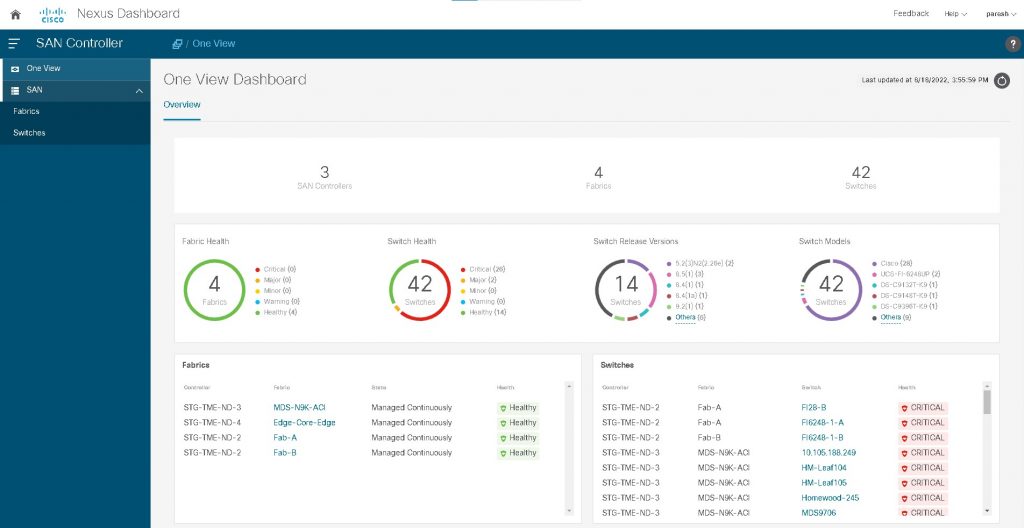Cisco Nexus Dashboard Fabric Controller (NDFC) is a scalable application for managing Fibre Channel SAN. However, in some cases a single NDFC server may not be efficient. For example, it may be a better solution for large global environments to utilize a dedicated NDFC server for each region or department. But how do you get a centralized view of the global SAN infrastructure when using multiple instances of NDFC managing separate regions or departments?
The answer is NDFC One View. It delivers the centralized management and visualization of multiple SAN environments that are managed by different NDFC servers.
What does NDFC One View offer?
NDFC One View provides insights into what is happening within the Fibre Channel SANs at multiple locations in a single pane of glass. It offers the following:
- Executive Dashboard: Important and relevant information.
- Faster Troubleshooting: Centralized view of the fabric and switch health.
- Increased Collaboration: Define the access using Role-Based Access Control (RBAC).
- High Availability: Each participating NDFC server can run on a 3-node active-active Nexus Dashboard cluster.
- Simplicity: Single Sign-On (SSO) allows seamless click-thru navigation to any of the servers that participate within NDFC One View.
- One View in Context: One View is always just a click away via a breadcrumb regardless of the participating NDFC server.

You can view a summary of all the SAN switches across the globe on the NDFC One View Dashboard. However, for making a change on any of the switches, such as creating a zone, you must do that from the NDFC server that manages that switch. NDFC One View simplifies this inter-cluster navigation with a single log in, so you do not have to remember which switches are managed by which Nexus Dashboard (ND) clusters.
How does NDFC One View work?
NDFC One View is an intuitive presentation layer. Only when accessed, it uses the RESTful APIs over HTTPS transport for retrieving the data from the participating NDFC servers. NDFC One View doesn’t store any additional data, or increase the storage requirement of the ND clusters.
No Extra Licensing Requirements for NDFC One View
Unlike other competing solutions, there is no extra license for NDFC One View. If you already have DCNM advanced license for managing Fibre Channel switches, you can start using NDFC One View today with no added cost.
How is NDFC One View different from Cisco Nexus Dashboard One View?
Cisco Nexus Dashboard (ND) One View and NDFC One View are different features. ND One View provides centralized management of Nexus Dashboard itself, which is a hosting platform in which applications such as NDFC can run. In contrast, NDFC One View provides centralized management of the global SAN Infrastructure that is managed by different NDFC servers.
How is NDFC One View different from DCNM Federation?
DCNM SAN, the predecessor of NDFC, provides high availability using a Federation. The participating DCNM servers in a federation must use an externally shared Oracle RAC database, which increases the total cost of ownership. In contrast, Nexus Dashboard integrates all the required services, including the distributed database services, which provide native active-active clustering. This design makes NDFC One View even more affordable.
How-to setup NDFC One View?
It’s easy. First, configure remote authentication for the Nexus Dashboard clusters. Then, add the address and the credentials under Infrastructure > Cluster Configuration > Multi Cluster Connectivity.
To learn more, watch the “How to setup NDFC One View” video
Conclusion
NDFC One View provides centralized management of multiple Fibre Channel SANs that are managed by different NDFC servers. Unlike other competing solutions, there is no extra license for NDFC One view to manage your global SAN Infrastructure.
- Unlock the full value of your Storage Area Networking solution.
- Store data securely and access it faster with Cisco MDS 9000 series switches.
- Protect your investment with 64G-capable speed and high performance for NVMe/FC and all-flash array storage environments.
- Work smarter with automation, gain deep visibility, and safeguard your data with Cisco SAN solutions.
To learn more, there is a wealth of information located in the Resources section below.
Resources
Web: Nexus Dashboard – configure, operate, and analyze across data center and cloud
Web: Nexus Dashboard Fabric Controller (Formerly DCNM)
Miercom Report: Cisco MDS DIRL SAN Congestion Software Performance Validation
Video: Prevent SAN congestion and slow drain using Dynamic Ingress Rate Limiting (DIRL)
Solution Overview: Accelerate the Performance of All-Flash NVMe Storage Arrays with DIRL
FAQ: Slow-Drain Device Detection and SAN Congestion Prevention
Cisco Blog: 64G FC Done Right and Slow-Drain Prevention with DIRL
Cisco Blog: Cisco introduces Dynamic Ingress Rate Limiting – A Real Solution for SAN Congestion
Cisco Blog: SAN Congestion Innovation with Cisco DIRL.
Cisco Live Session: Ed Mazurek – DIRL the Real Solution For SAN Congestion
Optimize, Accelerate, and Simplify SANs Non-disruptively
Cisco SAN Insights Discovery (SID) Tool

CONNECT WITH US